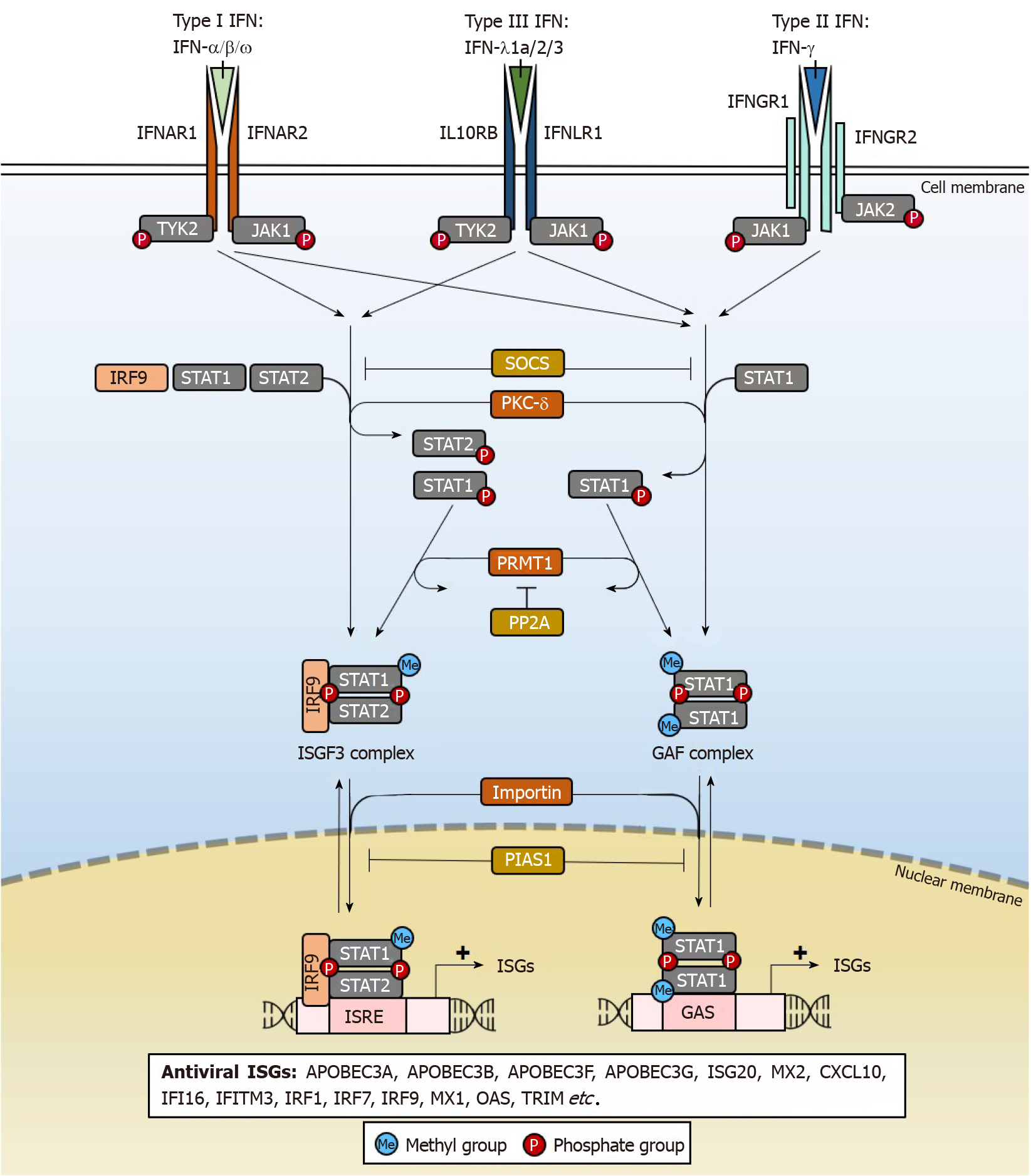Copyright
©The Author(s) 2021.
World J Gastroenterol. Apr 14, 2021; 27(14): 1369-1391
Published online Apr 14, 2021. doi: 10.3748/wjg.v27.i14.1369
Published online Apr 14, 2021. doi: 10.3748/wjg.v27.i14.1369
Figure 1 Activation of antiviral interferon-stimulated genes by different interferon subtypes.
Different subtypes of interferons (IFNs) bind to their cognate receptors to trigger IFN signalling pathways. The activate janus kinase/signal transducers and activators of transcription-dependent signalling results in the formation of transcription complexes that induce the expression several IFN-stimulated response elements-dependent and gamma activated site-dependent antiviral IFN-stimulated genes (ISGs), which target covalently closed circular DNA (cccDNA) stability and function through a variety of mechanisms. The potency of IFN sub-type for cccDNA degradation or silencing is dependent on the types and number of ISGs induced. IFN: Interferon; TYK2: Tyrosine kinase 2; SOCS: Suppressor of cytokine signalling; PKC-δ: Protein kinase C-delta; IRF: Interferon regulatory factor; JAK: Activate janus kinase; STAT: Signal transducers and activators of transcription; ISGF: Interferon-stimulated gene factor; GAF: Gamma-activated factor; ISGs: Interferon-stimulated genes; ISRE: Interferon-stimulated response elements; GAS: Gamma activated site.
Figure 2 Interferon treatment silences covalently closed circular DNA transcription and recruits APOBECs to actively degrade covalently closed circular DNA.
Covalently closed circular DNA (cccDNA) exists as an episomal mini chromosome that is epigenetically modified to support active transcription. Interferon (IFN)-α treatment results in the recruitment of histone modifying complexes that remove activating transcription post-translational modifications (PTMs), and add repressive PTMs that silence cccDNA function. These complexes can be recruited by IFN-stimulated genes (ISGs) such as IFI16. ISGs may also bind directly to cccDNA to repress transcription. Other ISGs such as APOBECs induced by IFN signalling are also recruited by HBc, generating AP sites which lead to cccDNA degradation. HBV: Hepatitis B virus; IFN: Interferon; IRF: Interferon regulatory factor; JAK: Activate janus kinase; STAT: Signal transducers and activators of transcription; ISGs: Interferon-stimulated genes; ISRE: Interferon-stimulated response elements; cccDNA: Covalently closed circular DNA.
Figure 3 Anti-covalently closed circular DNA strategies and antagonistic hepatitis B virus proteins that modulate the interferon signalling pathway.
Hepatitis B virus (HBV) has developed multiple mechanisms that target different parts of the intracellular interferon (IFN) signalling pathway to avert elimination by IFN treatment. Therapeutic agents that counter HBV anti-IFN signalling activities or enhance the strength of host cell IFN signalling may be beneficial to increase the efficiency of IFN treatment for the elimination or silencing of covalently closed circular DNA. HBV: Hepatitis B virus; IFN: Interferon; PEG: Pegylated form; SOCS: Suppressor of cytokine signalling; PKC-δ: Protein kinase C-delta; IRF: Interferon regulatory factor; JAK: Activate janus kinase; STAT: Signal transducers and activators of transcription; Pol/RT: Polymerase/reverse transcriptase; TNF: Tumour necrosis factor; ISGs: Interferon-stimulated genes; ISRE: Interferon-stimulated response elements; cccDNA: Covalently closed circular DNA.
- Citation: Goh ZY, Ren EC, Ko HL. Intracellular interferon signalling pathways as potential regulators of covalently closed circular DNA in the treatment of chronic hepatitis B. World J Gastroenterol 2021; 27(14): 1369-1391
- URL: https://www.wjgnet.com/1007-9327/full/v27/i14/1369.htm
- DOI: https://dx.doi.org/10.3748/wjg.v27.i14.1369











